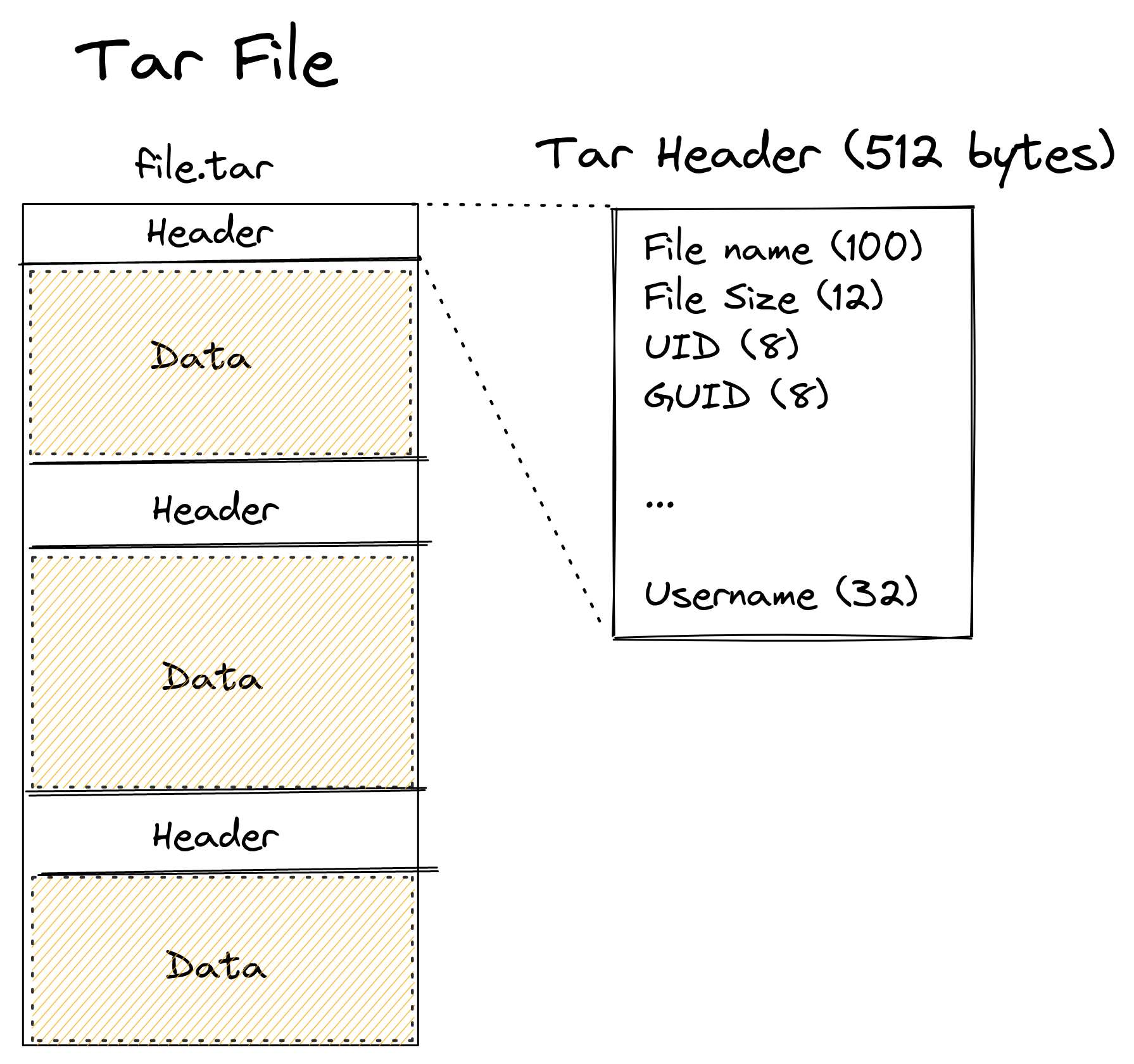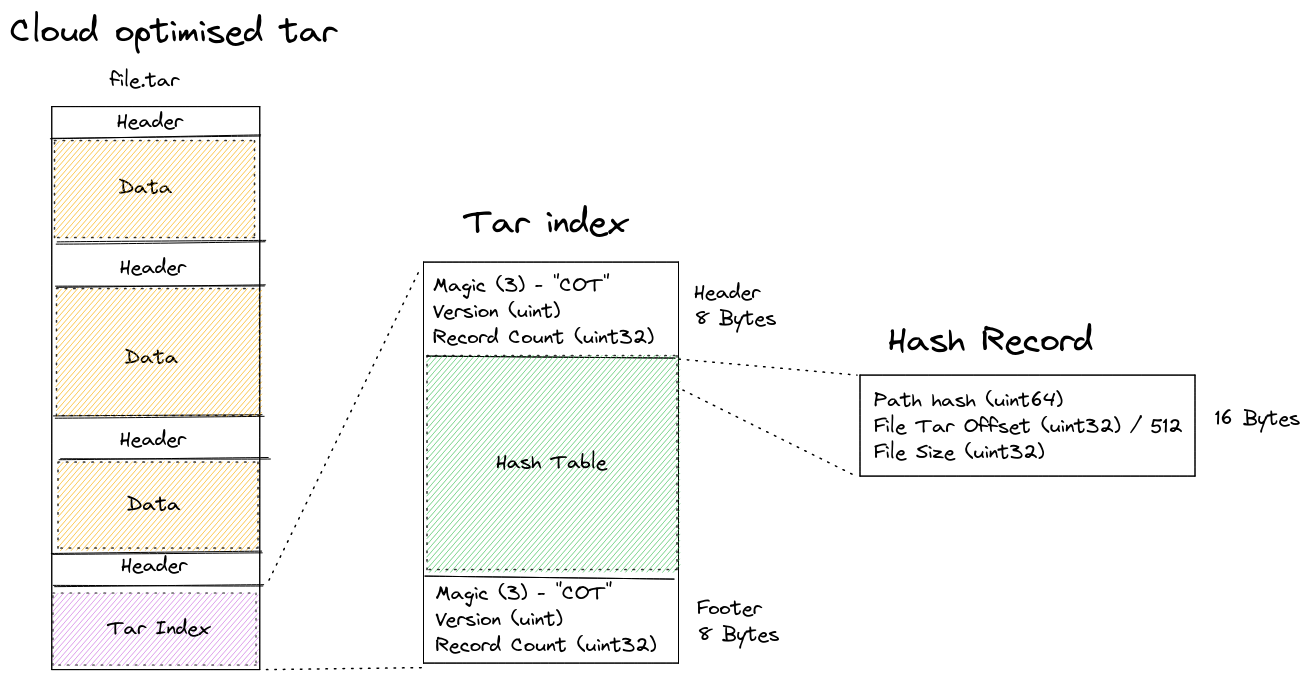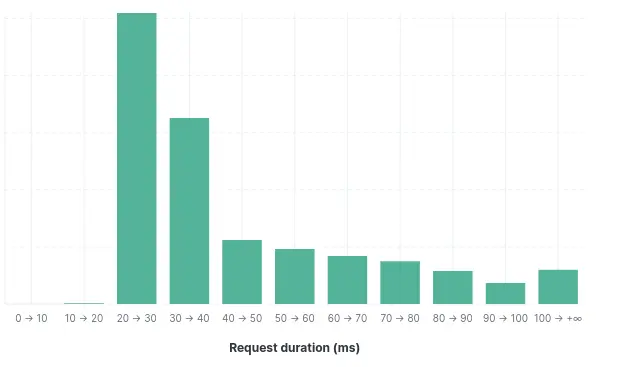.tar + .tar.index + AWS S3 = ❤️
Storing 100,000,000's of small file in cloud providers (S3, GCP) is expensive as each individual file update counts as a put request and for each 1M files costs around $5 USD to add to Amazon S3. This often limits how often files can be updated.
To work around this issue files can be packed into a archive so there is only one put/get request to receive all the files. However generally to extract a single file from most archives generally requires a full copy of the archive to find the file and extract it. This forces the user to download GBs of data when they only want a single file of a few KB.
Cotar works by creating a index of any .tar file whereby any individual file inside the archive can be extracted by using a single HTTP range request to the .tar archive.
- Supports any tar file and any contents - Currently focused on Mapbox vector tiles (MVT)
- Should be able to handle large 100GB+ tar files with millions of internal files
- Index should be small and/or compressed to save space
- Should be able to fetch ideally any file inside a archive with a minimal amount of requests (Ideally 1-2)
TAR files contain a collection of files stored sequentially into the file. With every file containing a 512 byte header just before the file data is stored.
This makes it very easy to add new files to a archive as more files can just be appended to the end, however this makes random reads impossible, as every file header would have to be read until the specific file wanted would be found
TAR Index (.index) is a binary file containing the location and size of a file inside of a tar. with this index a tar file can be randomly read.
- Internal file count is limited to
uint32this limits the tar to ~4 Billion files - Internal file sizes are limited to
uint32this stops the indexer from indexing files inside the tar that are over 4GB in size - Internal File block offsets are limited to
uint32however tar's are block aligned at 512 byte intervals so the final tar size is limited to 2TB
V1 was using 24 bytes per index record, using uint64 for hash, file offset and file size. This was inefficient as most files inside the archives are < 100KB in size
V2 moves to a uint32 for offsets, it changes from raw byte offset in the file to block offset. tar files are block algined at 512byte intervals. to get the raw offset const rawOffset = blockOffset * 512 this limits the tar to 2TB in size.
V2 moves to uint32 for file size this limits internal files to 4GB in size
Performance regression is monitored with hyperfine-action with results being hosted on github pages benchmarks.html
Hosting a COTAR inside of AWS S3, a requesting service would need to do three requests to the COTAR to find a random file inside the archive, and would generally only need to load in a few KB of overhead
- Read the COTAR header (8 bytes), this gives the size of the archive aswell as the number of records
- Read the hash entry of the file (~2KB), this gives the size of the file and the offset in the archive. The hash entry the position to the index record can be calculated on the client size
offset = hash(fileName) % recordCountand will always be within 100 records of that location and generally less than 5. So only a very small portion of the index needs to be read. - Read the file data from the archive
Real world: Using a lambda function reading a tar file from the same region the read performance can vary quite signifcantly, but generally a 64KB read request generally completes between 20-50ms. This means that from a completely cold cache a random small file can be read between 60-150ms, if the record count is known before (eg as part of the filename) then only 2 requests are required which will generally complete between 40-100ms.
Hash size The type of the hash could be changed as well as the number of bits of the hash used based on how unique the file hashes are, a uint64 hash is mostly completely wasted on a tar file containing 100 files. conversely a tar file containing 2,000,000 files needs a hash much larger than 16bits
Hash type
FNV-1a was chosen as it is implementation simplicity and provides a pretty good distribution of hash values for a 64bit hash.
Any hash type could be used farmhash or even sha256 and then the bits sliced down to the number needed for the hash index.
Zip has a Central Directory (CD) at the end of the file which makes it easier than a TAR to find files in the archive as the reader of the archive only has to scan the CD instead of the entire file. However finding a file inside the CD is not easy as each index is variable length. To Find a specific file inside the ZIP archive the reader would need to read a large portion of the index. For a test file with 600,000 records the CD was 55MB.
Minio works around this by creating a smaller index of the CD and then using the index to lookup the CD and File Record
MPQ has a very similar format to COTAR with a hash index at the start of the file which makes it cloud optimized by default, the biggest issue is not a an open standard and does not have much open tooling for reading and creating archives.
- Cloud Optimised GeoTiff COG
- PMTiles Cloud-optimized, single-file map tile archives
- flatgeobuf performant binary encoding for geographic data based on flatbuffers


